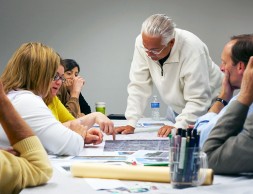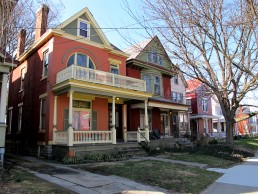The Cincinnati Form-Based Code led by Opticos was awarded the Grand Prize for Best Planning Tool or Process at the Congress for the New Urbanism’s 13th Annual Charter Awards in Buffalo, N.Y., held during CNU’s annual Congress, June 4 – 7.
“As the application of Form-Based Codes in major cities becomes more prevalent, it is important to recognize the best examples—the state of the art,” said juror Elizabeth Plater Zyberk.
Cincinnati’s Form-Based Code, one of the largest of its kind in the country, was adopted last year. It was designed to spur neighborhood revitalization in Cincinnati’s urban neighborhoods through pedestrian-friendly, mixed-use development, while preserving the city’s historic charm. Cincinnati has lost 40% of its population and the FBC is seen as a tool to encourage private investment.

“[The Cincinnati FBC] reinforces Cincinnati’s historic urban patterns with guidance for appropriate infill and predictable redevelopment building. A rigorous structure of community type, elements, intent, and policy facilitates the choices to be determined by each neighborhood for preservation, evolution or transformation,” Zyberk added.
The Form-Based Code was carefully coordinated with Cincinnati’s comprehensive plan through the integration of walkable urban place types. It is also expected to speed up development by streamlining the permit and approval process.
Opticos worked with Cincinnati city staff and a large national team of consultants to complete the FBC, including thoroughfare design by Hall Planning and Engineering, economic consulting from Urban Advisors, and retail consulting for neighborhood main streets by Kathleen Norris of UrbanFast Forward. Glaserworks provided design support and local coordination.
In May 2012, Opticos led a citywide charrette to include the public and all of Cincinnati’s neighborhoods in the process. Later in the year, a neighborhood charrette was held, in close collaboration with Urban Design Associates, for four focus neighborhoods, Westwood, Walnut Hills, Madisonville, and College Hill, which had signed on to participate and help finance the process.
The Cincinnati City Council voted unanimously to adopt the new Form-Based Code in May 2013. In February of this year, Westwood became the fourth of the four focus neighborhoods to apply the FBC amid overwhelming community support. The FBC was part of the city’s Plan Build Live Cincinnati initiative, a community-based process that aimed to boost the city’s economy, neighborhoods, and quality of life.
“We are thrilled and honored to have been selected for the Grand Prize by this esteemed jury for what we consider the preeminent award given for urban design,” said Opticos Principal Dan Parolek.
“We feel strongly that this code and process can serve as a model for other communities across the country, and will assist them in planning and coding as they work to meet the growing demand for walkable urban living.”

The CNU Charter Awards recognize a select number of projects for excellence in fulfilling and advancing the group’s charter principles, which define the essential qualities of walkable, sustainable places, from blocks, streets, and buildings, to neighborhoods, cities, and regions.
City planner and author Jeff Speck chaired an international jury of architects, designers, planners, and scholars who chose this year’s winners. For a complete list of this year’s CNU winners, click here. Read more about the CNU prize in this article from UrbanCincy.
The Cincinnati FBC was also given an honorable mention by the Form-Based Codes Institute’s Driehaus Form-Based Codes Award Jury. In a letter to Opticos, the jury called the Cincinnati FBC a “path-breaking code for applying Form-Based Codes citywide, but in an incremental way.”
The jury said the opportunity for neighborhoods to adopt place-specific codes allows the FBC to grow organically over time, while encouraging neighborhood-based planning, quality urban infill, and the improvement of a neighborhood’s existing buildings and fabric, and added that the Cincinnati code could serve as a model for future practice.
Like this article? How about these: